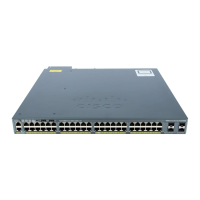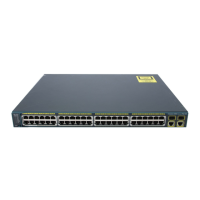Related Topics
Specifying the MST Region Configuration and Enabling MSTP, on page 59
Configuring the Root Switch, on page 62
Configuring Port Priority
If a loop occurs, the MSTP uses the port priority when selecting an interface to put into the forwarding state.
You can assign higher priority values (lower numerical values) to interfaces that you want selected first and
lower priority values (higher numerical values) that you want selected last. If all interfaces have the same
priority value, the MSTP puts the interface with the lowest interface number in the forwarding state and blocks
the other interfaces.
If the switch is a member of a switch stack, you must use the spanning-tree mst [instance-id] cost cost
interface configuration command instead of the spanning-tree mst [instance-id] port-priority priority
interface configuration command to select a port to put in the forwarding state. Assign lower cost values
to ports that you want selected first and higher cost values to ports that you want selected last. For more
information, see the path costs topic listed under Related Topics.
Note
This procedure is optional.
Beginning in privileged EXEC mode, follow these steps to configure a different port priority for the switch.
Before You Begin
A multiple spanning tree (MST) must be specified and enabled on the switch. For instructions, see Related
Topics.
You must also know the specified MST instance ID and the interface used. This example uses 0 as the instance
ID and GigabitEthernet1/0/1 as the interface because that was the instance ID and interface set up by the
instructions listed under Related Topics.
SUMMARY STEPS
1.
configure terminal
2.
interface interface-id
3.
spanning-tree mst instance-id port-priority priority
4.
end
Catalyst 2960-XR Switch Layer 2 Configuration Guide, Cisco IOS Release 15.0(2)EX1
64 OL-29424-01
Configuring Multiple Spanning-Tree Protocol
Configuring Port Priority

